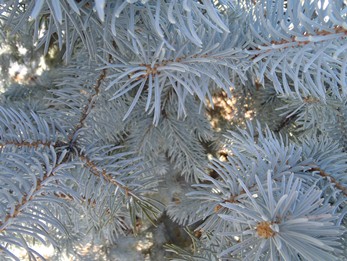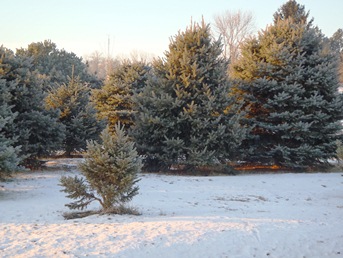With winter fully upon us, it can be hard to find color in our environment. The blue spruce is a great addition to any landscape for that wonderful blue color in the winter. It does well in Nebraska and is fairly easy to care for.
Blue spruce, Picea pungens var. glauca, is the blue variety of the Colorado spruce. It is a large tree that grows 30-60 feet tall and 10-20 feet wide, but can grow much larger in a natural setting. The blue spruce can vary in the degree of blue or green color depending on the seed source. It has prickly needles that are ¾ to 1¼ inches long. The needles have white lines on each side where the tiny pores, called stomata, are located. Blue spruces have cones that are 2 to 4 inches long, cylindrical, with wavy scales.
Fat Albert & Hoopsii
The many varieties of Colorado spruce allow you to select differences in shape, size, or blue/silver color. 'Fat Albert' is a good choice for pyramidal shape and only grows to 15 feet tall. 'Glauca Globosa' is a bush variety that grows only 3 feet by 3 feet and has needles that are blue. 'Hoopsii' is a great choice for a very intense blue-silver color and growth habits similar to 'Fat Albert'. 'Hoopsii' (photo to the left) is considered one of the best spruces with the bluest color, according to Michael Dirr in the book "Manual of Woody Landscape Plants".
Growing Blue Spruce
The blue spruce does well in most environmental conditions. It prefers moist soil rich with nutrients and does best in full sun, but is very adaptable and would survive in partial sun. Blue spruce does not tolerate poorly drained soils, so do not plant it where water tends to set. In the drought of 2012, many blue spruce trees had damage or even died due to the drought. That is an extreme drought situation that can be avoided with some extra watering by hand.
Pest Problems
Blue spruce can suffer from a few insect and disease problems. Bagworms produce the small bags that hang on cedars, spruces, and junipers. These insects typically don't do a great deal of damage and management is fairly easy - pull the bags off and place them in a bucket of soapy water or spray the tree with a pesticide labeled for bagworms in early June. Spider mites are commonly found on spruces in April to May and September to October and cause a brown appearance to the needles. These can be treated with a pesticide labeled for spider mites while they are present on the tree.
Needle cast disease and sirococcus shoot blight are two common diseases we see in blue spruces in early spring. These diseases cause needles to drop or turn brown. Treatment with a general fungicide should be done prior to establishment of the disease. Cytospora canker is another common problem on blue spruces where the top of the tree turns brown and loses the needles. There is no cure for canker - just keep the tree healthy so it doesn't develop this problem.
Blue spruce is an amazing tree for our landscapes. It gives us a great blue color in the otherwise brown or white winter environment. These trees can grow quite large and be used as a specimen tree, in a windbreak, or in many other locations on your acreage. This tree is susceptible to a few insect and disease problems, but with proper care these problems may never show up in your tree. The next time you are looking for a good evergreen tree for your landscape, consider Colorado blue spruce.


